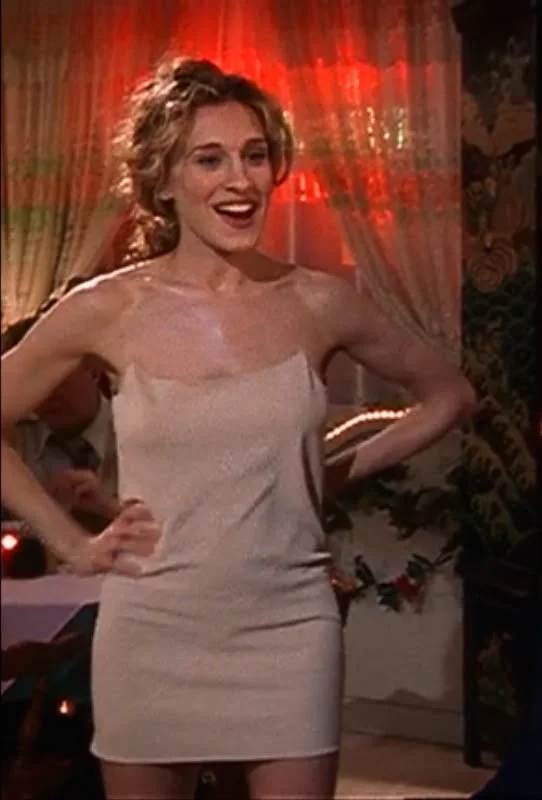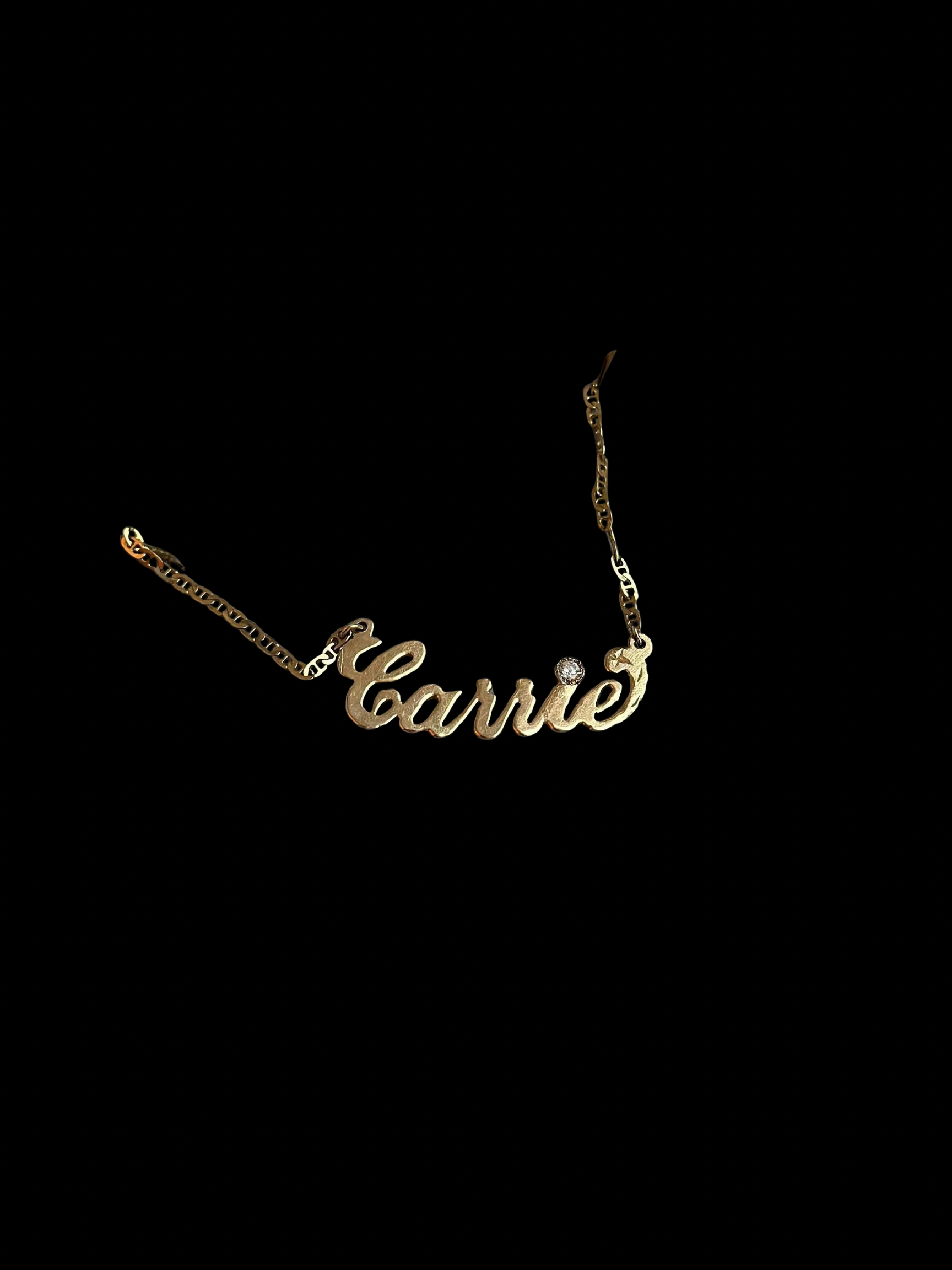HAUTE & the City: Carrie-d Away
Carrie Bradshaw, a fictional fashionista of Sex & the City, became a symbol of female independence and expressive style at the turn of the millennium. Emerging in an era (late 1980s through 1990s) often hailed as a high point of women’s freedom and empowerment, Carrie’s character embodied the modern urban woman who freely explores career, relationships, and fashion on her own terms. A New York newspaper columnist with a kryptonite for designer clothes and shoes, Carrie navigated life in Manhattan with unapologetically and boldly, as reflected within her style.
Eclectic Glamour & Personal Expression
Carrie Bradshaw’s style can best be described as eclectic, glamorous, and a little bit weird, yet authentic. Throughout Sex and the City, she mixes haute couture with thrift-shop finds, pairing designer pieces with quirky accessories in a way only she could pull off. This high-low mix became a blueprint for aspiring fashion girlies because it was “kooky yet cool, sexy in an unexpected way”, proving that personal style is reflected through creative self-expression. The goal was never to look “proper”, but it was to show her sense of self and joie de vivre through clothes.
This approach was rooted in the idea that fashion is fun, empowering, and expressive. As one style analysis noted, “Carrie uses fashion to express her feelings, she does not follow trends. This explains the bold outfit choices she makes throughout the series.” In other words, her wardrobe was like a visual diary, and demonstrated that style is a about being chic, along with confidence, creativity, and embodying your identity.
Key Elements of Carrie’s Wardrobe
Many of Carrie’s ensembles are now part of pop culture’s fashion hall of fame. Here are some signature elements and iconic pieces that define her look from the original series:
Tutu Skirt & Tank Top: Carrie’s very first appearance in the opening credits features her in a frothy ballerina tutu paired with a simple pink tank top. This whimsical $5 thrift-shop tutu (scouted by Patricia Field) set the tone for her fearless style: feminine, playful, and unexpected. We see this style more in the later seasons, where carrie is seen frequently with midi skirts paired with a funky top or blazer.
“Naked” Dress: For her first date with Mr. Big, Carrie famously wears a slinky flesh-toned mini Donna Karan dress (“the naked dress”). This now-iconic nude slip dress symbolized Carrie’s bold confidence and sensuality. In the storyline, the outfit became a talking point about how quickly to sleep with a man when you first start seeing each other, essentially making the dress a metaphor for sexual freedom and the risks she was willing to take. It’s one of the earliest examples of Carrie using fashion to make a statement (in this case, about owning her desires).
Manolo Blahnik Shoes: If Carrie had a fashion love affair greater than any romance, it was with her shoes. Especially, she adored her Manolo Blahniks. “Anyone who knows Carrie Bradshaw knows that [Manolo Blahnik] is her absolute favorite shoe brand,” one retrospective observes. She wore Manolos everywhere, and even quipped that she’d spent “$40,000 on shoes and had nowhere to live” at one point. The show’s obsession with fabulous footwear helped cement shoes as “important subjects” in women’s lives and solidified Manolo Blahnik as a classic.
Designer It-Bags: Long before “it-bag” mania hit the mainstream, Carrie was toting a Fendi Baguette purse as her go-to handbag. In fact, one of the series’ most famous scenes involves Carrie getting mugged and pleading to keep her bag: “It’s not a bag, it’s a Baguette!”. That purple sequined Fendi baguette, tucked under her arm, signified the importance of fashion in her life (she literally risked her safety for it), and made her ability to make a single accessory into a statement about who she is.
Nameplate Necklace: A subtle yet meaningful staple was Carrie’s gold “Carrie” nameplate necklace, worn almost daily. This affordable little piece (not a luxury item at all) carried huge sentimental value for her. It was a token of her identity (literally wearing her name) and she once said it reminded her of who she was. In the series finale, when that necklace goes missing during her Paris adventure, Carrie’s despair at losing it (and joy at finding it again) mirrors her journey of losing and re-finding herself.
Statement Dresses: Carrie had a flair for headline-making dresses. One example is the John Galliano newspaper print dress that she wore in Season 3. She wore this dress during her famous run-in with Natasha, the ex-wife of the marriage Carrie broke up (‘BIG’ mistake). Another showstopper was the Atelier Versace “Mille Feuille” gown in the series finale: a huge cloud of tulle and silk in which Carrie falls asleep while waiting for Petrovsky. That extravagant gown (reportedly costing $80,000 on set) visually captured the fairytale-versus-reality tension of her Paris trip. Each outfit had a story behind it, making fashion an integral part of the plot.
Fashion as a Reflection of Life: The Psychology Behind the Style
Researchers and fashion psychologists have noted that Carrie’s bold style was her way of asserting control and identity in a chaotic dating world. As The Washington Post pointed out, Carrie believed “her safest investment was always herself”, hence her choice to spend thousands on shoes rather than secure an apartment. It’s a revealing character moment: instead of relying on Prince Charming or conventional security, she literally “invested” in fashion, which for her meant investing in joy and self-worth.
Indeed, many times the show uses Carrie’s closet to explore themes of judgment and autonomy. For example, the infamous episode when she’s shamed for her extravagant shoe habit after her silver Manolos got stolen at a party, prompted a reflection on why society is so quick to judge a single woman’s choices. Carrie’s unapologetic style was a rebellion against being told how women “should” behave or dress.
Moreover, Carrie’s fashion frequently coincided with the storyline. A famous example is when she participates in a fashion show: dressed in Dolce & Gabbana couture, she literally falls flat on her face on the runway, only to pick herself up and keep strutting. Not only was that scene comical, but it also symbolized Carrie’s resilience and ability to laugh off humiliation, with the extravagant look highlighting how high-stakes the moment felt.
Another instance: the vintage fur coat she wears repeatedly from the pilot onward, a slightly shabby but beloved piece, reflects her personality perfectly: it’s edgy, a bit nonconformist (fur in summer, why not?), and “cheap but chic”, much like Carrie’s scrappy approach to life in New York. In every season, as Carrie’s relationships shift, you can see her style subtly evolve – from the mini dresses and crop tops of her freewheeling single days to more refined looks during her serious engagement to Aidan, and back to eclectic drama when single again. This evolution underscores a key point: fashion was Carrie’s language for coping and self-reinvention.
Psychologically, what Carrie Bradshaw teaches us is that clothing can be an extension of the self. Her closet was essentially a palette for her emotions. It’s a testament to the show’s brilliance (and Patricia Field’s costume design) that something as frivolous as a belt or a pair of heels could convey so much about a woman’s inner life. Ultimately, Carrie’s style saga illustrates that fashion is intimately tied to psychology, serving as both a mirror and a shield for one’s inner world.
Carrie Concluded
Carrie Bradshaw’s style remains one for the ages: high-fashion glamour, personal quirkiness, and symbolic meaning. The late ’90s setting of Sex and the City was indeed a time when women were expressing themselves more freely than ever, and Carrie’s extravagant wardrobe was a celebration of that autonomy and creativity. She showed that a woman could love Manolos and haute couture, yet still be taken seriously as a writer and a friend; that one could be intelligent and fashion-forward, sexual and sentimental, all at once. Her closet, much like her city, was a playground of possibilities.
In the end, Carrie Bradshaw’s style taught us that fashion and psychology are intertwined. Our wardrobe can reflect our dreams, our mood, our growth. It can be our diary, our canvas, even our therapy. Carrie may be a fictional character, but her knack for “clothing as communication” left a very real mark on how women approach fashion and self-expression.
Whether she’s remembered for her wild curls or a pair of jeweled Manolos left in a closet, the message is the same: Wear your personality proudly. Carrie absolutely did, and that’s why her style will forever remain iconic, inspiring us to embrace both the fun and the meaning in what we choose to wear.


























